|
Linear
Mixed Effects Modeling
1. Mixed Effects Models
Mixed effects models
refer to a variety of models which have as a key feature both fixed and
random effects.
The distinction between
fixed and random effects is a murky one. As pointed out by
Gelman
(2005), there are several, often conflicting, definitions of
fixed effects as well as definitions of random effects. Gelman offers a
fairly intuitive solution in the form of renaming fixed effects and
random effects and providing his own clear definitions of each. “We
define effects (or coefficients) in a multilevel model as constant
if they are identical for all groups in a population and varying
if they are allowed to differ from group to group” (Gelman, p. 21).
Other ways of thinking about fixed and random effects, which may be
useful but are not always consistent with one another or those given by
Gelman above, are discussed in the next paragraph.
Fixed
effects are ones in which the possible values of the variable are
fixed. Random effects refer to variables in which the set of potential
outcomes can change.
Stated in terms of populations, fixed effects
can be thought of as effects for which the population elements are
fixed. Cases or individuals do not move into or out of the population.
Random effects can be thought of as effects for which the population
elements are changing or can change (i.e. random variable). Cases or
individuals can and do move into and out of the population. Another way
of thinking about the distinction between fixed and random effects is
at the observation level. Fixed effects assume scores or observations
are independent while random effects assume some
type of relationship exists between some scores or
observations. For instance, it can be said that gender is a fixed
effect variable because we know all the values of that variable (male
& female) and those values are independent of one another
(mutually exclusive); and they (typically) do not change. A variable
such as high school class has random effects because we can only sample
some of the classes which exist; not to mention, students move into and
out of those classes each year.
There are many types of
random effects, such as repeated measures of the same individuals;
where the scores at each time of measure constitute samples from the
same participants among a virtually infinite (and possibly random)
number of times of measure from those participants. Another example of
a random effect can be seen in nested designs, where for example;
achievement scores of students are nested within classes and those
classes are nested within schools. That would be an example of a
hierarchical design structure with a random effect for scores nested
within classes and a second random effect for classes nested within
schools. The nested data structure assumes a relationship among groups
such that members of a class are thought to be similar to others in
their class in such a way as to distinguish them from members of other
classes and members of a school are thought to be similar to others in
their school in such a way as to distinguish them from members of other
schools. The example used below deals with a similar design which
focuses on multiple fixed effects and a single nested random effect.
2. Linear Mixed Effects Models
Linear mixed effects
models simply model the fixed and random effects as having a linear
form. Similar to the General Linear Model, an outcome variable is
contributed to by additive fixed and random effects (as well as an
error term). Using the familiar notation, the linear mixed effect model
takes the form:
yij = β1x1ij
+ β2x2ij
… βnxnij
+ bi1z1ij
+ bi2z2ij
…
binznij
+ εij
where yij
is the value of the outcome variable for a particular ij case, β1
through βn are the fixed effect coefficients
(like regression coefficients), x1ij
through xnij are the fixed
effect variables (predictors) for observation j in group i (usually the
first is reserved for the intercept/constant; x1ij
= 1), bi1 through
bin are the
random effect coefficients which are assumed to be multivariate
normally distributed, z1ij through znij
are the random effect variables (predictors), and εij
is the error for case j in group i where each group’s error is assumed
to be multivariate normally distributed.
3. Example Data
The example used for this
tutorial is fictional data where the interval scaled outcome variable
Extroversion (extro) is predicted by fixed effects for the interval
scaled predictor Openness to new experiences (open), the interval
scaled predictor Agreeableness (agree), the interval scaled predictor
Social engagement (social), and the nominal scaled predictor Class
(classRC); as well as the random (nested) effect of Class (classRC)
within School (schoolRC) as well as the random effect of School
(schoolRC). The data contains 1200 cases evenly distributed among 24
nested groups (4 classes within 6 schools). The data set is available
here.
4. Running the Analysis
Begin by clicking on Analyze, Mixed Models,
Linear...
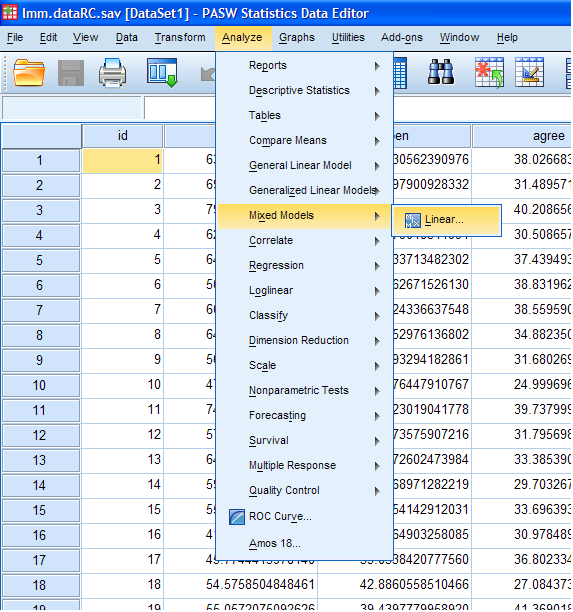
The initial dialogue box is self-explanatory; but
will not be used in this example so click the Continue button.

Next, we have the main Linear Mixed Models
dialogue box. Here we specify the variables we want included in the
model. Using the arrows; move extro to the Dependent Variable box, move
classRC and schoolRC to the Factor(s) box, and move open, agree, and
social to the Covariat(s) box. Then click on the Fixed... button to
specify the fixed effects.
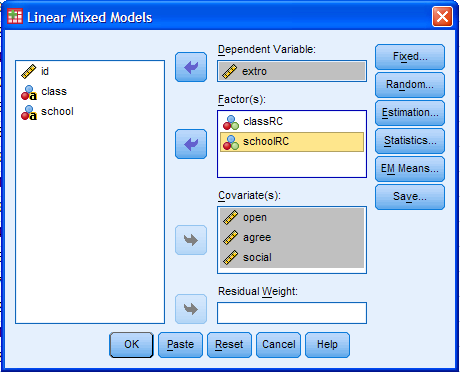
The fixed effects in a LINEAR mixed effects model
are essentially the same as a traditional ordinary least squares linear
regression. To specify the fixed effects, use the Add button to move
open, agree, social, and classRC into the Model box. Notice we are not
specifying any interaction terms for this model. Then click the
Continue button.
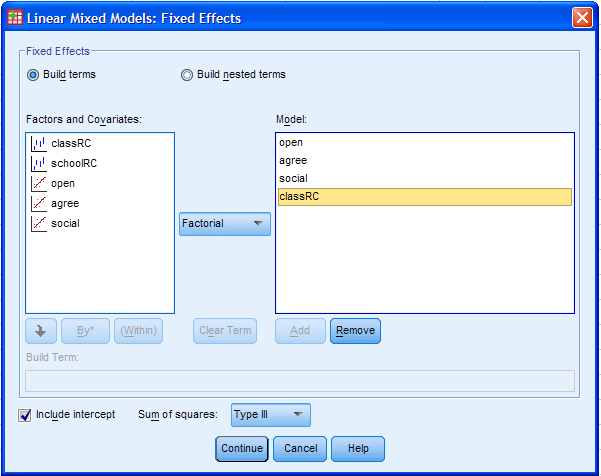
Next, click on the Random... button to specify the
random effects.

The first thing we need to do is click on the
Build nested terms circle (marked with the top, centered red ellipse).
Then, highlight / select the classRC factor and use the down arrow
button (marked with the lower, left red ellipse) to move classRC into
the Build Term box. Then click the (Within) button (marked with the
lower, middle ellipse). Next, highlight / select the schoolRC factor
and use the down arrow button again to move it inside the parentheses
created by the (Within) button. Next, click the Add button (marked with
a red ellipse inside a green ellipse) to move our nested term into the
Model box. Next, click on the Build terms circle (marked with the green
ellipse in the upper left). Then, highlight / select schoolRC factor
and use the Add button (marked with the green ellipse around the red
ellipse) to move schoolRC to the Model box. Next, click the Continue
button at the bottom of the dialogue box.
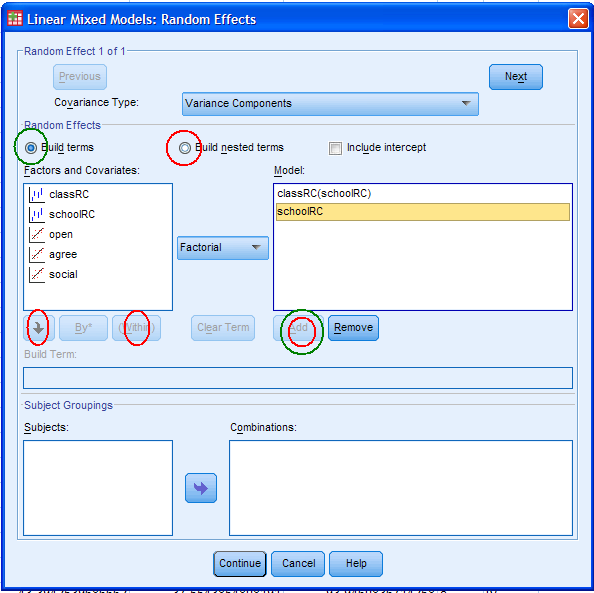
Next, click on the Estimation... button.

Next, change the Maximum iterations from the
default (100) to 150 (marked with the red soft rectangle). This step is
not technically necessary, but it insures the estimated values match
those produced in R using the lme4 package. Then, click the Continue
button.
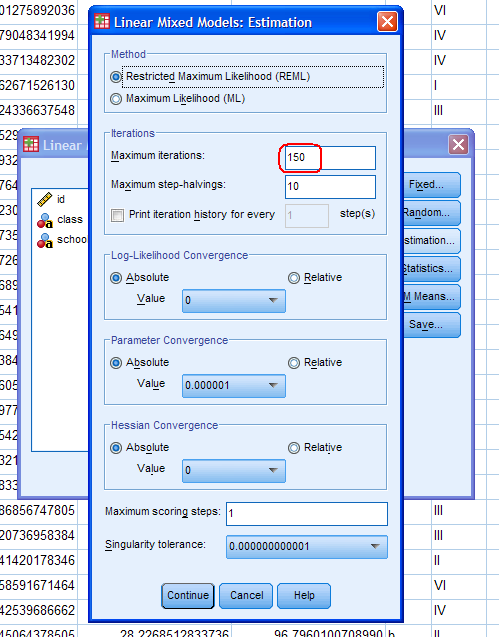
Next, click on the Statistics... button. While
some of the options are not necessary (Case Processing Summary), I
generally click all of them.

Next, click on the EM Means... button (Estimated
Marginal Means). When the (OVERALL) factor is moved to the Display
Means for box, the grand mean will be produced. The classRC factor is
present (and moved to the Display Means for box) because it is the only
factor (categorical variable) included in the model as a fixed effect.
The other fixed effects are not categorical and thus do not appear
here. Next, click the Continue button.
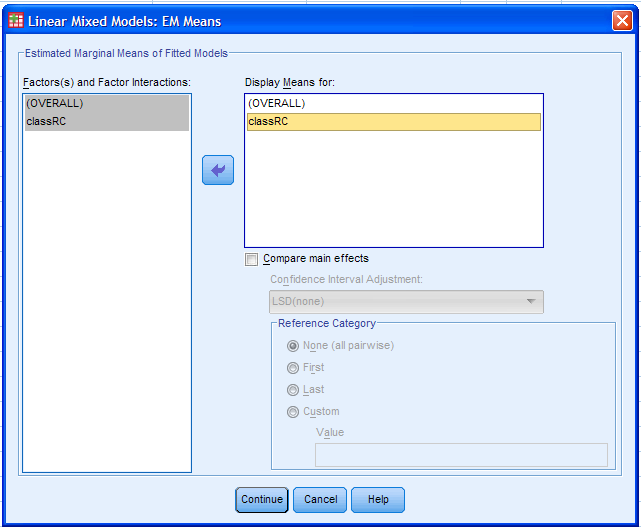
Next, click on the Save... button. It is generally
a good idea to save the Predicted values. The Fixed Predicted Values
will be predicted values based solely on the Fixed Effects part of the
model; while the lower Predicted Values & Residuals Predicted
values will be the whole model's predicted values. Next, click the
Continue button.
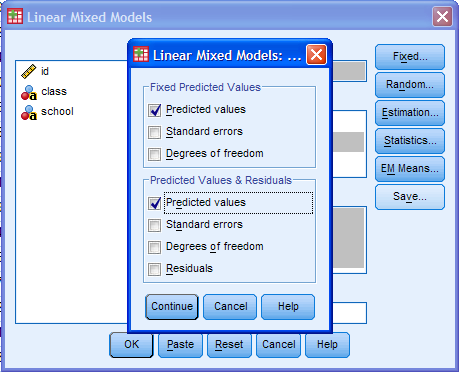
Then click the Paste button. Your syntax should
match what is below. The reason I recommend pasting the syntax is that
it takes quite a few clicks to create one of these types of models and
it is often the case that multiple models are run during a session and
changing variables or options is simply easier in the syntax than
pointing and clicking back through all the above steps.
Next, highlight / select all the text in the
syntax and then click the green 'run' arrow (marked with the red
ellipse).
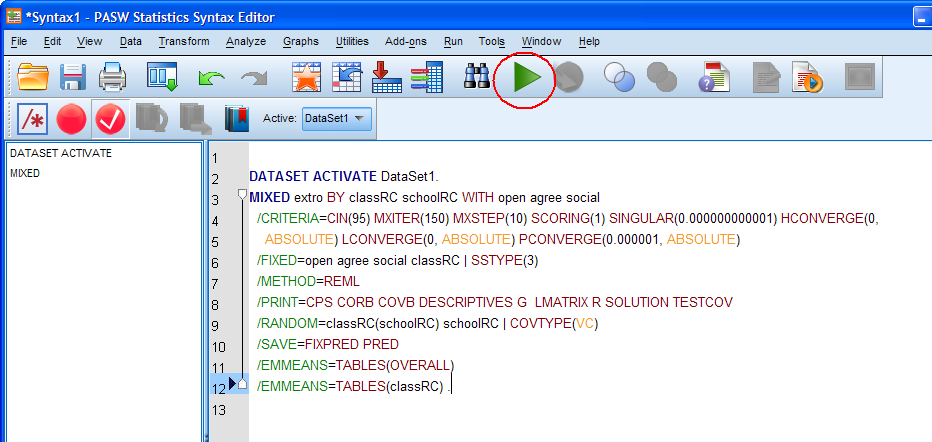
Your output should be the same as what is below.
5. Interpreting the
Output.
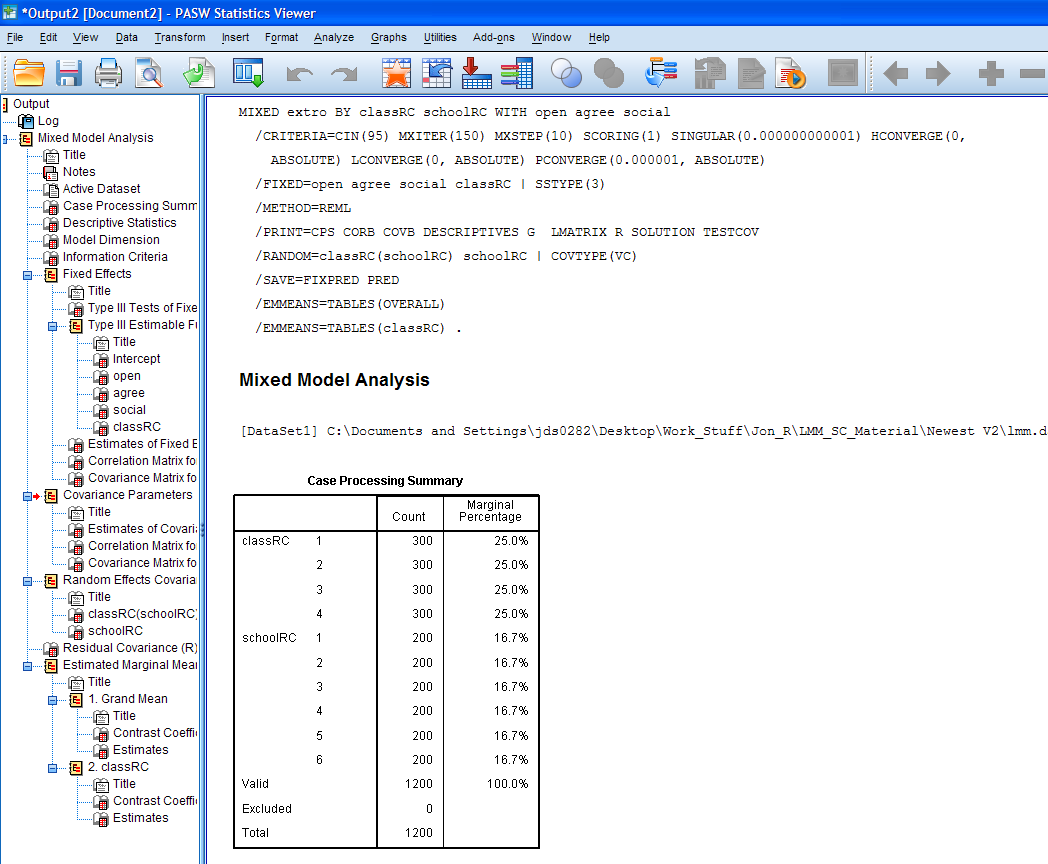
The Case Processing Summary (above) simply shows
that the cases are balanced among the categories of the categorical
variables and no cases were excluded.
The next, rather large table contains all the
descriptive statistics (only the very top of the table is shown here;
below).
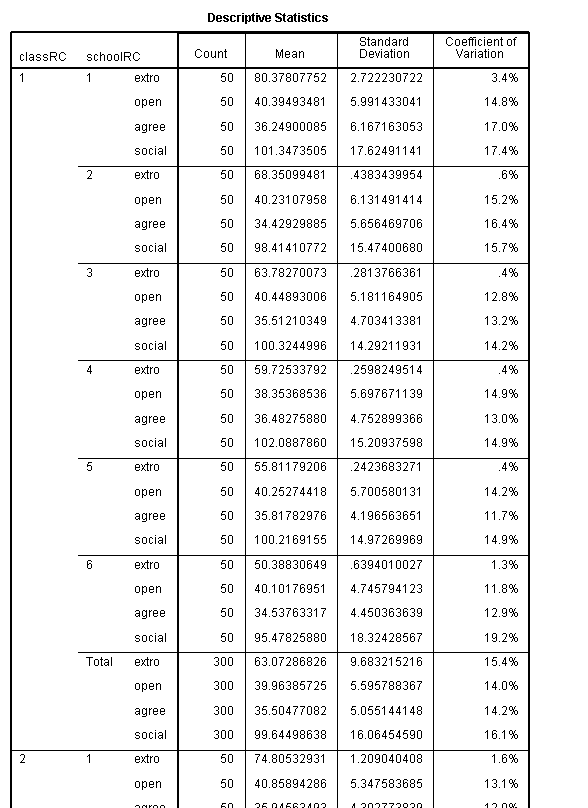
The Model Dimension table (below) simply shows the
model in terms of which variables (and their number of levels) are
fixed and / or random effects and the number of parameters being
estimated.
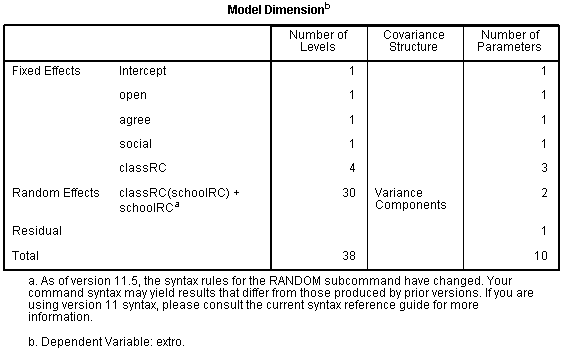
The next table displays fit indices. For each
index; the lower the number, the better the model fits the data.
Generally I use and recommend the Bayesian Information Criterion (BIC).
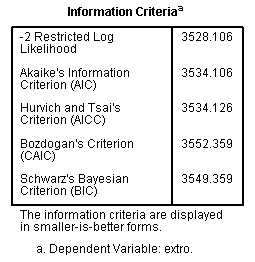
The next table contains the results of the Fixed
Effects tests; here we see the intercept and the classRC variables
appear to be the main contributors.
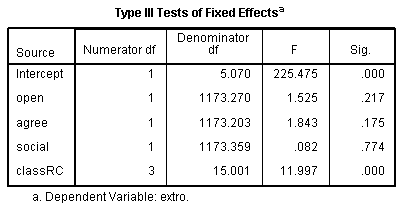
The next 5 tables do not offer much information
and simply show each parameter function (only the first and part of the
second tables of the five are shown below).
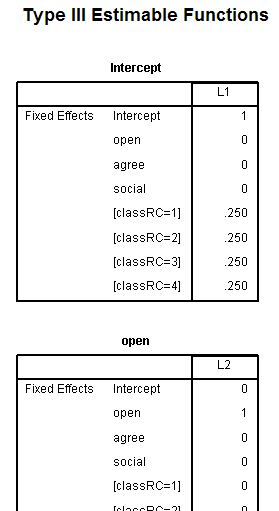
The next table "Estimates of Fixed Effects"
(below) is very important and shows the parameter estimates for the
Fixed Effects specified in the model. It should be clear, this table
and its interpretation are exactly like one would expect from a
traditional ordinary least squares linear regression. One thing to note
is the way SPSS chooses the reference category for categorical
variables. You may have noticed we have been using the classRC and
schoolRC variables instead of the original class and school variables
in the data set. The RC variables contain the same information as the
original variables, they simply have been ReCoded or Reverse Coded so
that the output here will match the output produced using the lme4
package in the R programming language. It is important to know that
SPSS (and SAS) automatically choose the category with the highest
numerical value (or the lowest alphabetical letter) as the reference
category for categorical variables. All packages I have used in the R
programming language choose the reference category in the more
intuitive but opposite way. In the lme4 package (and others I've used)
in R, the software automatically picks the lowest numerical value (or
the earliest alphabetically letter) as the reference category for
categorical variables. This has drastic implications for the intercept
estimate and more troubling, the predicted values produced by a model.
For example, if this same model is specified with the original
variables (not reverse coded) then the Fixed Effects intercept term is
63.049612; so you can imagine how much different the predicted values
would be in that model compared to this model where the intercept is
57.383879. Recall from multiple regression, the intercept
is
interpreted as the mean of the outcome (extro) when all the predictors
have a value of zero. The predictor estimates (coefficients or slopes)
are interpreted the same way as the coefficients from a traditional
regression. For instance, a one unit increase in the predictor Openness
to new experiences (open) corresponds to a 0.006130 increase in the
outcome Extroversion (extro). Likewise, a one unit increase in the
predictor Agreeableness (agree) corresponds to a 0.007736 decrease
in the outcome Extroversion (extro). Furthermore,
the categorical predictor classRC = 3 has a coefficient of 2.054798;
which means, the mean Extroversion score of the third group of classRC
(3) is 2.0547978 higher than the mean Extroversion score of the last
group of classRC (4). ClassRC (4) was automatically coded as the
reference category.
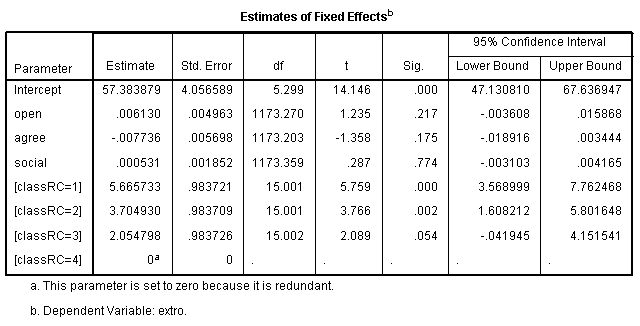
The next 2 tables simply show the correlation
matrix and covariance matrix for the fixed effects estimates. We can
see that multicollinearity is not an issue among the predictors
because, their correlations (and covariances) are quite low (except of
course, the categories of the classRC variable which as expected, are
related).
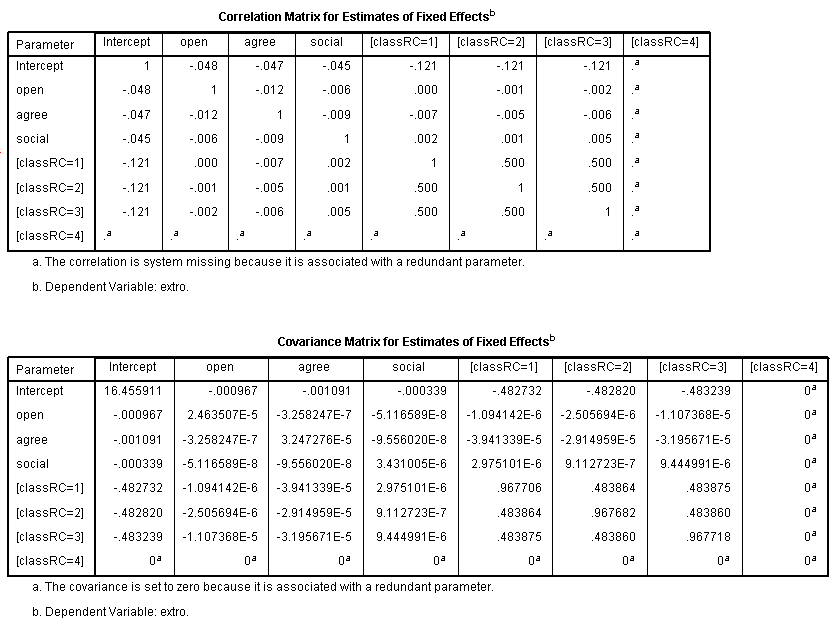
Next, we have the Estimates of Covariance
Parameters table (below); which are the parameter estimates for the
Random Effects. These are variance estimates (with standard errors,
Wald Z test statistics, significance values, and confidence intervals
for the variance estimates). Recall the ubiquitous ANOVA summary table
where we generally have a total variance estimate (sums of squares) at
the bottom, then just above it we have a residual or within groups
variance estimate (sums of squares) and then we have each treatment or
between groups variance estimate (sums of squares). This table is very
much like that, but the total is not displayed and the residual
variance estimate is on top. So, we can quickly calculate the total
variance estimate: 95.171929 + 2.883600 + .968368 = 99.0239 then we can
create an R? type of effect
size to gauge the importance of each random effect by dividing the
effect's variance estimate by the total variance estimate to arrive at
a proportion of variance explained or accounted for by each random
effect. This is analogous to an Eta-squared (η?) in standard ANOVA or
an R? in regression; it is sometimes referred to (in the linear mixed
effects situation) as an Intraclass Correlation Coefficient (ICC,
Bartko, 1976; Bliese, 2009). For example, we find that the nested
effect of classRC within schoolRC is 2.883600 / 99.0239 = 0.02912024 or
simply stated, that random nested effect only accounts for 2.9% of the
variance of the random effects. However, the random effect for schoolRC
alone accounts for 95.171929 / 99.0239 = 0.9611006 or 96% of the
variance of the random effects. If none of the random effects account
for a meaningful amount of variance in the random effects (i.e. if the
residual variance is larger than the random effect variance estimates),
then the random effects should be eliminated from the model and a
standard General Linear Model (or Generalized Linear Model) should be
fitted (i.e., a model with only the fixed effects). Notice,
SPSS does not calculate the standard errors correctly and therefore,
the confidence interval estimates and the results of the Wald Z test
are NOT valid. The Wald Z test simply divides the
estimate by its standard error to arrive at a Z-score to test for
significance with the standard normal distribution of Z-scores.
However, the standard errors do not match with the standard errors
produced when using the lme4 package in the R programming language. The
good news is that the variance estimates are correct (do match) and the
proportion of variance estimates can be correctly computed and used as
effect size measures.

The next two tables simply show the correlation
and covariances for the random effect parameter estimates.

The next three tables in the output are the Random
Effects Covariance Structure matrices. They are omitted here because
they are particularly useless and redundant; because each table simply
lists the parameter estimate for each random effect.
The last part of the output contains tables with
the Estimated Marginal means (EM means) for the Grand Mean and ClassRC.
The Grand Mean contrast coefficients table and
actual grand mean table (the overall mean of the outcome variable:
extro).
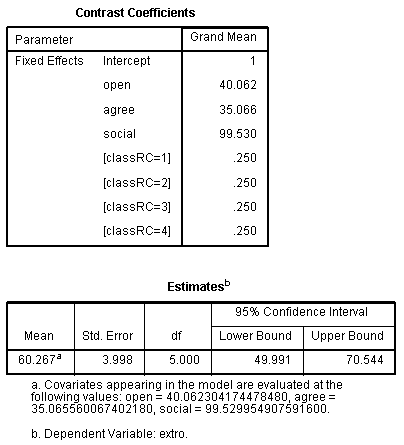
The ClassRC variable's contrast coefficients table
and mean extroversion (extro) for each group table.
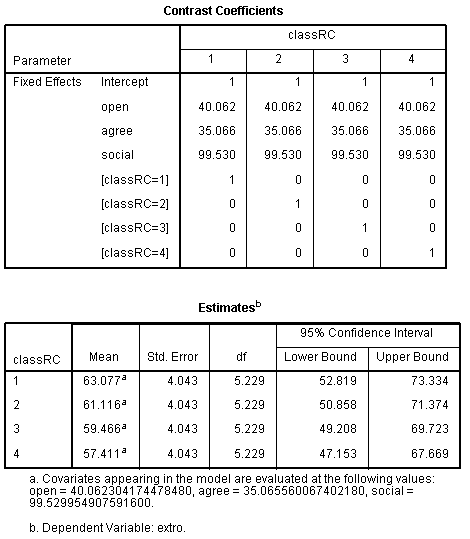
As with most of the tutorials / pages within this
site, this page should not be considered an exhaustive review of the
topic covered and it should not be considered a substitute for a good
textbook.
References / Resources
Akaike, H.
(1974). A new look at the statistical model identification.
I.E.E.E.
Transactions on Automatic Control, AC 19, 716 – 723.
Available at:
Bartko, J.
J. (1976). On various intraclass correlation reliability coefficients.
Psychological Bulletin, 83, 762-765.
http://bayes.acs.unt.edu:8083:8083/BayesContent/class/Jon/MiscDocs/Bartko_1976.pdf
Bates, D.,
& Maechler, M. (2010). Package ‘lme4’. Reference manual for the
package, available at:
http://cran.r-project.org/web/packages/lme4/lme4.pdf
Bates, D. (2010). Linear
mixed model implementation in lme4. Package lme4 vignette, available
at:
http://cran.r-project.org/web/packages/lme4/vignettes/Implementation.pdf
Bates, D. (2010).
Computational methods for mixed models. Package lme4 vignette,
available at:
http://cran.r-project.org/web/packages/lme4/vignettes/Theory.pdf
Bates, D. (2010).
Penalized least squares versus generalized least squares
representations of linear mixed models. Package lme4 vignette,
available at:
http://cran.r-project.org/web/packages/lme4/vignettes/PLSvGLS.pdf
Bliese, P. (2009).
Multilevel modeling in R: A brief introduction to R, the multilevel
package and the nlme package. Available at:
http://cran.r-project.org/doc/contrib/Bliese_Multilevel.pdf
Draper, D. (1995).
Inference and hierarchical modeling in the social sciences. Journal
of Educational and Behavioral Statistics, 20(2), 115 - 147.
Available at:
Fox, J.
(2002). Linear mixed models: An appendix to “An R and S-PLUS companion
to applied regression”. Available at:
http://cran.r-project.org/doc/contrib/Fox-Companion/appendix-mixed-models.pdf
Gelman, A.
(2005). Analysis of variance -- why it is more important than ever. The
Annals of Statistics, 33(1), 1 -- 53. Available at:
http://bayes.acs.unt.edu:8083:8083/BayesContent/class/Jon/MiscDocs/Gelman_2005.pdf
Hofmann, D.
A., Griffin, M. A., & Gavin, M. B. (2000). The application of
hierarchical linear modeling to organizational research. In K. J. Klein
(Ed.), Multilevel theory, research, and methods in
organizations: Foundations, extensions, and new directions (p.
467 - 511). San Francisco, CA: Jossey-Bass. Available at:
Raudenbush,
S. W. (1995). Reexamining, reaffirming, and improving application of
hierarchical models. Journal of Educational and Behavioral
Statistics, 20(2), 210 - 220. Available at:
Raudenbush,
S. W. (1993). Hierarchical linear models and experimental design. In L.
Edwards (Ed.), Applied analysis of variance in behavioral
science (p. 459 - 496). New York: Marcel Dekker. Available at:
Rogosa, D.,
& Saner, H. (1995). Longitudinal data analysis examples with
random coefficient models. Journal of Educational and
Behavioral Statistics, 20(2), 149 - 170. Available at:
Schwarz, G.
(1978). Estimating the dimension of a model.
Annals
of Statistics, 6, 461 – 464. Available at:
Return to the
SPSS
Short Course
|
























